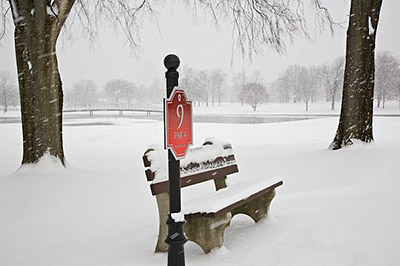
"I had been trying to consider how to tackle the theme of "Empty" for a recent TDS photo assignment, when a significant snowstorm provided the inspiration," said Mike Doel. "In addition to knowing that the golf course would be empty, I figured that it would also be a good example of one of the tips I've learned from The Digital Story - try to find photos that catch views that are unique or unexpected."
How Mike Did It
"When I arrived at the course, the first thing I did was to get permission to take photos. Having received that (as well as a "you've got to be nuts" look) from the staff member in the pro shop - surprisingly still open for business - I headed out with my Canon 5D, my Canon EF 24-105 f/4.0 L IS USM lens, and my tripod. The first tee box was cluttered with fallen branches and other debris, so I hiked down the ninth fairway to get a better shot."
"The shot was composed with five main elements - the red sign that tells the viewer we're at a golf course, the "empty" bench which reinforces the theme of the assignment, the two trees on either side, and the background with the lake and foot bridge. The shot is perhaps a bit too symmetrical (it would have been better if I gotten the bench a bit more to the side), but I was having a tough time doing that without obscuring the bridge. I especially liked how the red of the sign stood out against the white background, and it was the sign that I focused on."
"From another one of Derrick's tips, I knew that snowy scenes like this can fool your camera's light meter, which expects to find scenes with lots of midtones. Since snow is white and not 18% gray, I knew I had to over-expose the image to get the right color. I figured about 1 and 1/3 stops of over-exposure would do the trick, but I ended up using Aperture's exposure slider to actually boost it a bit more in post-production. The shot was taken in manual exposure mode at an aperture of f/16, shutter speed of 1/60th of a second, and an ISO of 100. The 1/60th of a second shutter speed is just long enough to provide a bit of motion to the falling snow."
"When shooting in really cold temperatures like this, you have to be careful about bringing your camera back into warmer temperatures - especially if it's into a room with any significant humidity in the air. The water in the air could condense onto your cold camera equipment (similar to what happens when people with eyeglasses come inside from the cold) and cause all kinds of havoc. A good tip is to put your camera into a gallon ziplock bag before coming inside. Once the camera has warmed up to room temperature, it is safe to take it out of the bag."
Photo of 9th Tee by Mike Doel.
More Tips from The Digital Photography Companion
"How I Did It" is a new feature of The Digital Story featured on The Digital Photography Companion mini site. These are techniques from virtual camera club members who have built upon information in The Digital Photography Companion, or have come up with new tips altogether.
We're building a living library of knowledge for everyone to use (and contribute to). If you have a "How I Did It" tip to share, just send it to me with the sample photo, and put "How I Did It" in the email subject.
Technorati Tags: digital photography, Digital Photography Companion, technique, Technology, The Digital Story, How I Did It












That is some inspirational stuff. Never knew that opinions could be this varied. Thanks for all the enthusiasm to offer such helpful information here.